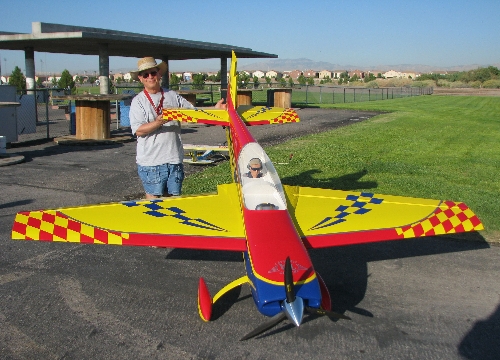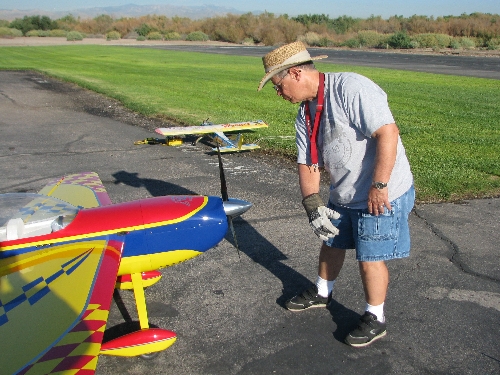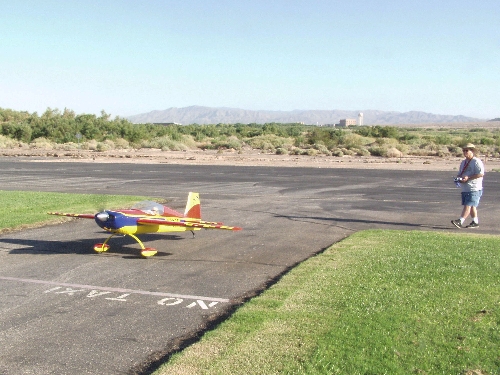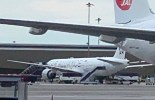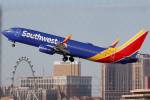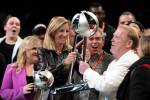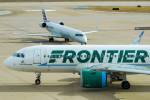Aerobatics enthusiasts to compete at William Bennett Field
In most neighborhoods, it would be unheard of to see airplanes doing stalls, loops and other tricks just a few dozen feet off the ground, but for residents near William Bennett Field, 7200 E. Russell Road, it's business as usual for one of the valley's few radio control airplane facilities.
The action should be a little more intense this weekend when the International Miniature Aerobatic Club hosts the annual Southwest Region Aerobatic Competition. Wayne McGartlin, president of the Las Vegas Radio Control Club and organizer of the contest, hopes to bring in around 50 competitors from California, Arizona, New Mexico, Utah and Nevada and perhaps even outside of the region.
"Anyone who comes here from a different region is welcome to fly, too," McGartlin said. "We're hoping to have a good crowd."
The competition is divided into five classes: basic, sportsman, intermediate, advanced and unlimited .
"Every class has a specific set of required maneuvers," said Gil Terzo, who will be competing in the sportsman class. "Everyone in your class is going to do the exact same maneuvers in the exact same order."
Terzo retired as a commercial pilot six months ago and gets out to the field two or three times a week. He admits that flying radio control planes is a bit of a busman's holiday, but he said he can do things with remote in hand that he could never have dreamed in his former day job. There were no barrel rolls in his 737.
"They sort of frown on that in the airlines," Terzo said with a laugh. "With the airlines it was take off, cruise for four hours and land. With this, I can go out and have some fun."
McGartlin said most of the competitors will be flying 35- or 40-percent scale aircraft. Many are gasoline-powered, but there are usually some electric-powered planes, too.
"The 35-percent scale planes usually have 85 to 120cc engines and the 40-percent scale planes usually have 150cc to over 200cc engines," McGartlin said. "The electric ones have an engine about the size of a beer can and batteries more than twice as big."
There are no restrictions on types of planes in the competition, provided they're scale aerobatic planes.
"My plane has a 122-inch wingspan," Terzo said. "It's 96 inches long and weighs about 40 pounds. It's got a 150cc two-cylinder engine and a 28-inch diameter, three-blade carbon fiber propeller."
Terzo explained that there are different advantages to two- and three-blade propellers. The three-blades are a little quieter, but the two-blades are lighter, and the engine will spool up faster because of that.
"It's about a $6,000 plane," Terzo said. "Obviously it's not a beginner's plane. You can get a little beginner's plane and some support equipment for $400 or $500."
The cost to compete is $50 for International Miniature Aerobatic Club members and $60 for nonmembers. A number of radio control equipment companies have contributed items for distribution at the event.
"We'll have what we call a pilot's drawing," McGartlin said. "The sponsors send stuff and we lay it all out and draw names, and the pilots pick out what they want."
Contact Sunrise/Whitney View reporter F. Andrew Taylor at ataylor@viewnews.com or 380-4532.
If you go
The International Miniature Aerobatic Club's Southwest Region Aerobatic Competition is scheduled Friday through Sunday at William Bennett Field, 7200 Russell Road, just north of Sam Boyd Stadium. Friday is a practice day. Registration begins at 7 a.m. and flying at 9 a.m. Admission for spectators is free. For more information, visit lvrcc.com, call 275-0604 or email tmay@ecwise.com or mcgartlin@cox.net.



